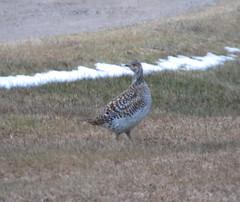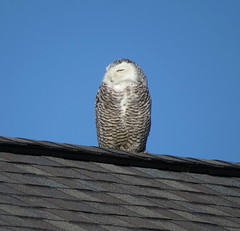Daniel Drake Park, California Woods, Magrish Riverlands Preserve, Armleder Park, Avoca Trailhead Park, & Grand Valley
If you haven’t noticed by now, yesterdays field trip involved following the Little Miami River north from California Woods, and ending at Grand Valley. Granted Daniel Drake Park doesn’t border the Little Miami, however it is on the way, so I stopped there first. Several weeks ago a Pine Warbler was sighted there, so I thought I’d see if the bird was still there. They have a nice stand of Evergreens which would entice me if I was a Pine Warbler.
 Now there’s something about Pine Warblers that drives me nuts. They sound almost identical to Chipping Sparrows. So for over an hour I chased down every song that sounded like a Pine Warbler, only to find it to be another Chipping Sparrow. A Pine Warbler was later spotted at Avoca Trailhead.
Now there’s something about Pine Warblers that drives me nuts. They sound almost identical to Chipping Sparrows. So for over an hour I chased down every song that sounded like a Pine Warbler, only to find it to be another Chipping Sparrow. A Pine Warbler was later spotted at Avoca Trailhead.
From there it was a short drive to California Woods to try and find another target bird for the day, a Louisiana Waterthrush. Lick Run Creek runs through this 113 acre heavily wooded forest. And it’s along this creek that I hope to find the Waterthrush. I’ve seen Waterthrush here in the past, and some recent sightings has given me confidence that I’ll spot at least one. I hope. For 30 minutes I walked up and down the road hearing and see everything but a Louisiana Waterthrush. I didn’t want to get too far away from the creek and hike up into the woods, even as tempting as it looked. At one point I went back to the bird-mobile and reacquainted myself with it’s song. 2 minutes later I hear the song coming from the nature center. The song was loud and clear and constant. I had it cornered in a bend of the creek prior to the bridge when it flew to a nearby tree and continued to sing. Getting a proper ID on it was the easy part, getting a picture was different. Like most Warblers, they don’t like to sit still long enough for photos. Digi-binning a was out of the question, so I pulled out my other camera and took this photo.
 I wish the Waterthrush was as cooperative as this Eastern Towhee.
I wish the Waterthrush was as cooperative as this Eastern Towhee.
2 minutes after leaving California Woods, I pull into Magrish Riverlands Preserve. This is one of my favorite spots for migrant Warblers and with the dry weather we’ve had lately, it should be relatively dry. Well I was correct on the dry part. For the hour I spent here I would have thought the birding would be better than it was. Picking up a couple FOS birds, I made my way to Armleder Park, where the bulk of the day I was going to spend.
Armleder Park was a bustle of activity as I pulled in. I think every dog owner in Cincinnati had their dogs romping in the enclosed dog parks. That’s right they have 2 of them now. I guess it’s like an overflow parking lot for dogs. Families were out in force with young ones in tow as they biked, hiked, skated, their way around the paved paths that loop around and through the park. For myself it was onto the “Bean Field”. And what do my wondering eyes should appear, but Great Egrets.
As the Sun rose higher, the morning frost finally melted away and more layers of clothing peeled off. Getting along into the late morning and early afternoon my target birds of Savannah and Vesper Sparrows were becoming harder to find. I did find one Savannah Sparrow as it hide under a bush.
I dipped on the Vesper Sparrow but I did have some luck with 2 fly over Rusty Blackbirds. I did find one Song Sparrow that held still long enough for me to get these 2 pretty good pictures.
The Tree Swallows were everywhere today. Laying claim to empty Bluebird houses, they were easy to photograph as they lighted on the post that held up the bird house.
With a couple of hours till needing to be back home I left Armleder Park and followed the river to Avoca Trailhead Park. Situated along the bike trail this is a small park with river access. Plus it has a lot of potential for some good birding. This is where I picked up a Pine and Yellow-throated Warbler. With one more stop before home I left Avoca Trailhead Park on my way to Grand Valley. Which turned out to be rather disappointing. If there were any ducks on the lake they were all scared off by the fisherman and children playing. I was able to spot one lone Horned Grebe which I thought was a great find considering.
Notable birds for the day include:
- Mourning Dove
- Rock Dove
- Northern Cardinal
- Tufted Titmouse
- Carolina Chickadee
- Blue Jay
- White-throated Sparrow
- White-crowned Sparrow
- Song Sparrow
- Savannah Sparrow
- Field Sparrow
- Chipping Sparrow
- House Sparrow
- House Finch
- American Goldfinch
- Common Grackle
- Common Crow
- Rusty Blackbird
- Red-winged Blackbird
- Canada Goose
- American Robin
- American Coot
- Mallard
- Wood Duck
- Blue-winged Teal
- Great Egret
- Great Blue Heron
- Lesser Yellowleg
- Pectoral Sandpiper
- Killdeer
- Bank Swallow
- Northern Rough-winged Swallow
- Barn Swallow
- Tree Swallow
- Eastern Towhee
- Louisiana Waterthrush
- Yellow-rumped (Myrtle) Warbler
- Pine Warbler
- Downy Woodpecker
- Red-bellied Woodpecker
- Yellow-bellied Sapsucker
- Brown-headed Cowbird
- Carolina Wren
- Cooper’s Hawk
- Red-tailed Hawk
- Turkey Vulture
- Eastern Meadowlark
- Horned Grebe
- Pied-billed Grebe
- Northern Mockingbird
- Belted Kingfisher




















